The Health Education Assets Library (HEAL) is a collection of over 22,000 freely available digital materials for health sciences education. The collection is now housed at the University of Utah J. Willard Marriott Digital Library.
TO
Filters: Collection: ehsl_heal
| Title | Description | Subject | Collection | ||
|---|---|---|---|---|---|
| 551 |
 |
Immunohistochemistry with cellular markers in thymus (rat) | Stain: Alexa 594 red immunofluorescence. (1) medulla; (2) cortex; (3) septa. (A): Strong CD8 staining of the thymic cortical lymphocytes (single CD8+ and double positive CD4+CD8+ thymocytes). (B): OX19 staining for almost all T cells, equivalent to T1 human marker and Ly-1 mouse marker. Note that... | cyclophosphamide; CD8 monoclonal antibody; OX19 monoclonal antibody; ER1 monoclonal antibody | Poja Histology Collection - Lymphatic Tissues and Organs Subset |
| 552 |
 |
Immunoperoxidase stained CD3 positive T cells in spleen (rat) | Stain: Immunoperoxidase staining using diaminobenzidin (DAB)/ hematoxylin counterstained on frozen section with anti CD3 antibodies. Survey (A) and detail (B) show that CD3 marker for mature T cells stains positively (brown) in the PALS area (1) around the central arteries, while the adjacent follic... | CD3 lymphocytes; immunohistochemistry; PALS | Poja Histology Collection - Lymphatic Tissues and Organs Subset |
| 553 |
 |
Immunoperoxidase stained CD8 positive T cells in spleen (rat) | Stain: Immunoperoxidase staining using diaminobenzidin (DAB)/ hematoxylin counterstained on frozen section with anti-CD8 antibodies. A, B and C show brown-stained CD8-positive T cells or Tc cells at different enlargements. The CD8 Tc/s cells are localised predominantly in the PALS area (1), while th... | CD8 lymphocytes; immunohistochemistry; PALS | Poja Histology Collection - Lymphatic Tissues and Organs Subset |
| 554 |
 |
Lingual tonsil ('lymphoepithelial tissue', 'gut-associated lymphatic tissue' or GALT) (human) | Stain: Azan. A: Survey; B: detail of the crypt. The lingual tonsil consists of accumulations of bulging lingual lymphatic follicles in the dorsal part of the tongue behind the terminal sulcus, and belongs to the so-called Waldeyer's ring of pharyngeal lymphatic tissue. The left (A) and right (B) ... | lingual tonsil; GALT; Non-keratinized stratified squamous epithelium; crypt | Poja Histology Collection - Lymphatic Tissues and Organs Subset |
| 555 |
 |
Lingual tonsil ('lymphoepithelial tissue', 'gut-associated lymphatic tissue' or GALT) (human) | Stain: Azan. A: Left side shows a secondary lymphatic follicle (1) separated by the connective tissue of the proper lamina (2) from the lining non-keratinized stratified squamous epithelium (3). The mantle zone (4) is indicated by the peripheral dense aggregations of (memory) B lymphocytes. (5) diff... | lingual tonsil; GALT; non-keratinized stratified squamous epithelium | Poja Histology Collection - Lymphatic Tissues and Organs Subset |
| 556 |
 |
Localization of B cells in spleen (rat) | Stain: Immunofluorescence of Vector red using Mark-1 antibody against B cells. The T cells in the PALS (periarteriolar lymphatic sheath) remain unstained (1, dark). The red-stained B cells are packed in the germinal centre (2), the corona (3) or mantle layer that diffuses into the marginal zone and... | B lymphocytes; immunofluorescence; PALS | Poja Histology Collection - Lymphatic Tissues and Organs Subset |
| 557 |
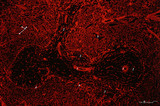 |
Localization of heparan sulfate (HS) in spleen (rat) | Stain: Immunofluorescence of Alexa 594 red labeled single chain antibody 3C3 for heparan sulfate (HS). The antibody stains HS epitopes of the meshwork of reticulum cells and the basal membrane of blood vessels. (1) central arteries in the T cell area of the PALS (2). The B cell area in the follic... | white pulp; heparan sulfate; PALS | Poja Histology Collection - Lymphatic Tissues and Organs Subset |
| 558 |
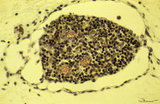 |
Lymph node (fetus, human) | Stain: Trichrome (Goldner). Along the course of lymphatic vessels lymph nodes develop. Lymphatic vessels dilate and form lymphatic sacs and lymphocytes aggregate around these sacs. A tiny developing lymph node with dense-stained thymocyte nuclei is closely associated with dilated lymph capillaries. ... | fetal lymph node; development | Poja Histology Collection - Lymphatic Tissues and Organs Subset |
| 559 |
 |
Lymph node (human) | Stain: Silver stain (Gomori). Due to the argyrophilia of reticular fibres the reticular network is black-stained among others such as collagen type I, III, IV. From the fibrous capsule (1) a meshwork of fine reticular fibres penetrates into the cortex of a lymph node crossing the subcapsular (or m... | germinal center; argyrophilia; reticular fibers | Poja Histology Collection - Lymphatic Tissues and Organs Subset |
| 560 |
 |
Lymph node (human) | Stain: Azan. Left: subcapsular (or marginal) sinus in lymph node. Right: higher magnification. Both pictures show a thick capsule (1), at (2) subcapsular (or marginal) sinus filled with lymphocytes indicate (lining) littoral cells (?). Reticular cells (3) are localized perpendicularly through sin... | subcapsular sinus; reticular cell | Poja Histology Collection - Lymphatic Tissues and Organs Subset |
| 561 |
 |
Lymph node (human) | Stain: Azan. Part of the cortex of a lymph node with the capsule (1) and subcapsular (or marginal) sinus (2) filled with lymphocytes. From the blue-stained dense capsule a long trabecula (3) flanked by paratrabecular (intermediate) sinuses penetrates between the paracortical areas (6). Paratrabecula... | Poja Histology Collection - Lymphatic Tissues and Organs Subset | |
| 562 |
 |
Lymph node (human) | Stain: Azan. Part of the cortex of a lymph node with the capsule (1) and subcapsular (or marginal) sinus (2) filled with lymphocytes. Below the subcapsular sinus a darkly stained rim or corona (3) of small lymphocytes (B cells) surrounds the lucid stained germinal centre (4). The white spaces repre... | follicle; germinal center | Poja Histology Collection - Lymphatic Tissues and Organs Subset |
| 563 |
 |
Lymph node (human) | Stain: Azan. Left and right: survey of lymph nodes, compare the individual differences between the nodes. The pictures display the cortex (1) with capsule (3), and the medulla (2). The cortex consists of (secondary) follicles displaying a clear germinal centre (4). The paracortex (T cell area) is ... | follicle; paracortex; cortex; germinal center | Poja Histology Collection - Lymphatic Tissues and Organs Subset |
| 564 |
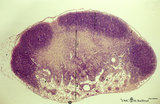 |
Lymph node (mouse) | Stain: Hematoxylin & eosin. For comparison with the human lymph node a survey of a small rodent lymph node is demonstrated. Basically the same divisions are found: (1) a cortex (outer cortex zone, nodular cortex or superficial cortex) covered with a (2) thin capsule and subcapsular sinus; a paracor... | follicle; hilum; medulla; cortex | Poja Histology Collection - Lymphatic Tissues and Organs Subset |
| 565 |
 |
Lymph node (rat) | Electron microscopy. In the paracortical area (inner cortex) of a lymph node interdigitating cells (1) are found (so-called IDC, antigen-presenting cell or APC). They show branched extensions (3) in between the closely apposed surrounding T lymphocytes (2). In the cytoplasm of the IDC lysosomal inc... | electron microscopy; interdigitating cell; antigen-presenting cell | Poja Histology Collection - Lymphatic Tissues and Organs Subset |
| 566 |
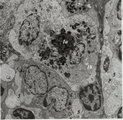 |
Lymph node (rat) | Electron microscopy. Within the reticular framework of lymph nodes a variety of active reticular cells are present, some of them (1) have phagocytised foreign material (1a) and contain numerous lysosomal structures (1a) and large Golgi areas (1b)). Others are less active (2). (3) wandering interdig... | electron microscopy; interdigitating cell; antigen-presenting cell | Poja Histology Collection - Lymphatic Tissues and Organs Subset |
| 567 |
 |
Lymph nodes (rat) | Stain: Hematoxylin & pyronin. Pyronin was formerly used to demonstrate young blast cell types rich in polysomes and packed rough endoplasmic reticulum (RER) resulting in a reddish stain of the cytoplasm. A: Part of the medulla with medullary cords (1) and medullary sinuses (2) close to the hilum o... | infection; medullar cord; plasma cells ; macrophages | Poja Histology Collection - Lymphatic Tissues and Organs Subset |
| 568 |
 |
Lymphoblast in splenic cord of red pulp (rat) | Electron microscopy. A free circulating more matured lymphoblast with a conspicuous nucleus and nucleolus (1) still contains many polysomes (2), the swollen mitochondria (3) are obvious. A single fat droplet (4) and Golgi vesicles (5) are present. The cell is partly surrounded by reticular cell exte... | electron microscopy; lymphoblast | Poja Histology Collection - Lymphatic Tissues and Organs Subset |
| 569 |
 |
Lymphoblast in splenic white pulp (rat, human) | Electron microscopy (A, rat) and Methyl green (B, human). Upon antigenic stimulation the lymphocytes in the germinal centre proliferate and generate activated B cells or lymphoblasts which seed towards marginal zone and red pulp while differentiating. Due to the increased number of lymphoblasts, ret... | electron microscopy; lymphoblast | Poja Histology Collection - Lymphatic Tissues and Organs Subset |
| 570 |
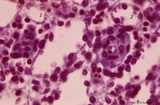 |
Macrophage-sheathed capillaries in spleen (human) | Azan. The branching of each penicillar arteriole gives rise to capillaries and a slow-down of the blood stream. In certain regions monocyte-derived macrophages leave the capillary and enter its wall where they develop into macrophages. Together with the present reticular cells these cell accumulatio... | macrophage-sheathed capillaries; penicillar arterioles; sinusoid | Poja Histology Collection - Lymphatic Tissues and Organs Subset |
| 571 |
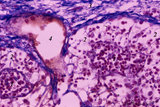 |
Medulla of lymph node (human) | Stain: Azan. Part of the medulla showing medullary cords (1) and medullary sinuses (2) close to the hilum and capsule (3). The medullary cords consist of a meshwork of reticular fibers and reticular cells (blue-stained). The cords (1) are more stuffed with lymphocytes and other blood cells. The sinu... | medullar cords; medullar sinus; hilum | Poja Histology Collection - Lymphatic Tissues and Organs Subset |
| 572 |
 |
Medulla of thymus (human, puberty) | Stain: Hematoxylin. The light-stained medulla consists of a loosened framework of epithelial reticular cells, macrophages, thymocytes and capillaries. Accumulations of a specialized type of epithelial reticular cells (1) are localized between the thymocytes. These clusters represent precursors of fu... | thymic corpuscle (Hassalls); epithelioreticular cell (ERC); thymus medulla; lymphoid tissue | Poja Histology Collection - Lymphatic Tissues and Organs Subset |
| 573 |
 |
Medullary cords and sinus in lymph node (mouse) | Stain: Trichrome (Goldner). Detail of medullary sinus (1) flanked by part of medullar cords (2). The sinus space (1) is lined by flattened littoral cells (foamed cytoplasm) (?) and dispersedly filled with lymphocytes (4) and macrophages (brown hemo-pigment) (3). Within the medullary cords one finds ... | medullar cords; medullar sinus | Poja Histology Collection - Lymphatic Tissues and Organs Subset |
| 574 |
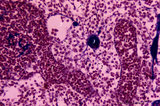 |
Medullary part of lymph node (human) | Stain: Azan. Part of the medulla with darkly stained medullary cords (1) and lightly stained medullary sinuses (2). The cords are stuffed with densely packed lymphocytes and reticular cells. Their blue-stained structures indicate massive bundles of reticular fibres. The sinuses are lined by flattene... | medulla; medullar cords; sinus | Poja Histology Collection - Lymphatic Tissues and Organs Subset |
| 575 |
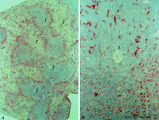 |
MHC-class II dendritic cells in spleen (rat) | Stain: Immunohistochemistry of Vector red staining of MHC-class II with ER13 antibody. The survey in (A) shows that MHC-class II expressing cells are conspicuously concentrated in dendritic cell types (B) in the transition zone between red pulp (2) and white pulp (1). These dendritic or antigen-pres... | MHC class II; dendritic cells; immunofluorescence | Poja Histology Collection - Lymphatic Tissues and Organs Subset |
